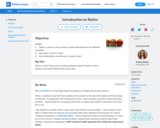
Students will learn how to find the Greatest Common Factor of two or more numbers by using math manipulatives.
- Subject:
- Mathematics
- Material Type:
- Lesson Plan
- Provider:
- BetterLesson
- Date Added:
- 12/01/2022

Students will learn how to find the Greatest Common Factor of two or more numbers by using math manipulatives.

Students re-create a big green monster!

SWBAT identify the subtraction and addition sign and understand their function by hopping a bunny up and down a number line.

SWBAT make a connection between number names and written numbers to the quantities they represent. They will also practice ordering numbers and quantities up to 12. Students will also document a solution to a problem

SWBAT order a set of numbers and quantities up to 12 and compare two quantities up to 10 to see which one is greater. The students will also demonstrate their knowledge of how the numbers in the counting sequence are related (that each number is 1 more or 1 less than the number before or after it).

Who's the REAL meat eater here? Let's do some math and find out!

Students will extend their understanding of hundreds, tens and ones using dollars, dimes and pennies as another way to express groups of 100, 10 and 1.

Numbers don't stop at 20! We spend the last week or so of school looking at the numbers beyond 20. Today we do it through exploring a 100 Chart.

SWBAT place numerals in order from least to greatest on a number line.

What is a ratio? How can we create equivalent ratios? Students work to express and extend relationships using ratios.

SWBAT identify and build numbers based on base ten language.

Students will be working with rulers to measure real life objects along with manipulating a ruler in a Smart Board activity!

Students can find patterns in 4-digit numbers that will help them when counting over decades and centuries.

I want my students to realize that numbers are everywhere and math is applicable to almost all other subjects. Geography offers a perfect opportunity for students to make this connection.

Students will be able to compare objects.

Revisit, Revisit, Revisit! Students need repeated exposure to math concepts to really understand how they work.

Students will be able to locate specific areas and objects to learn about their new school setting.

What are loans and how do they work? How do banks encourage people to save money? Students work on these questions in the context of the College Project.

This lesson solidifies students' understanding of time to the hour (while enriching with basic geography content) and continues to build back up to 3rd grade goal of time to the minute.

Making equivalent ratios using multiple representations.